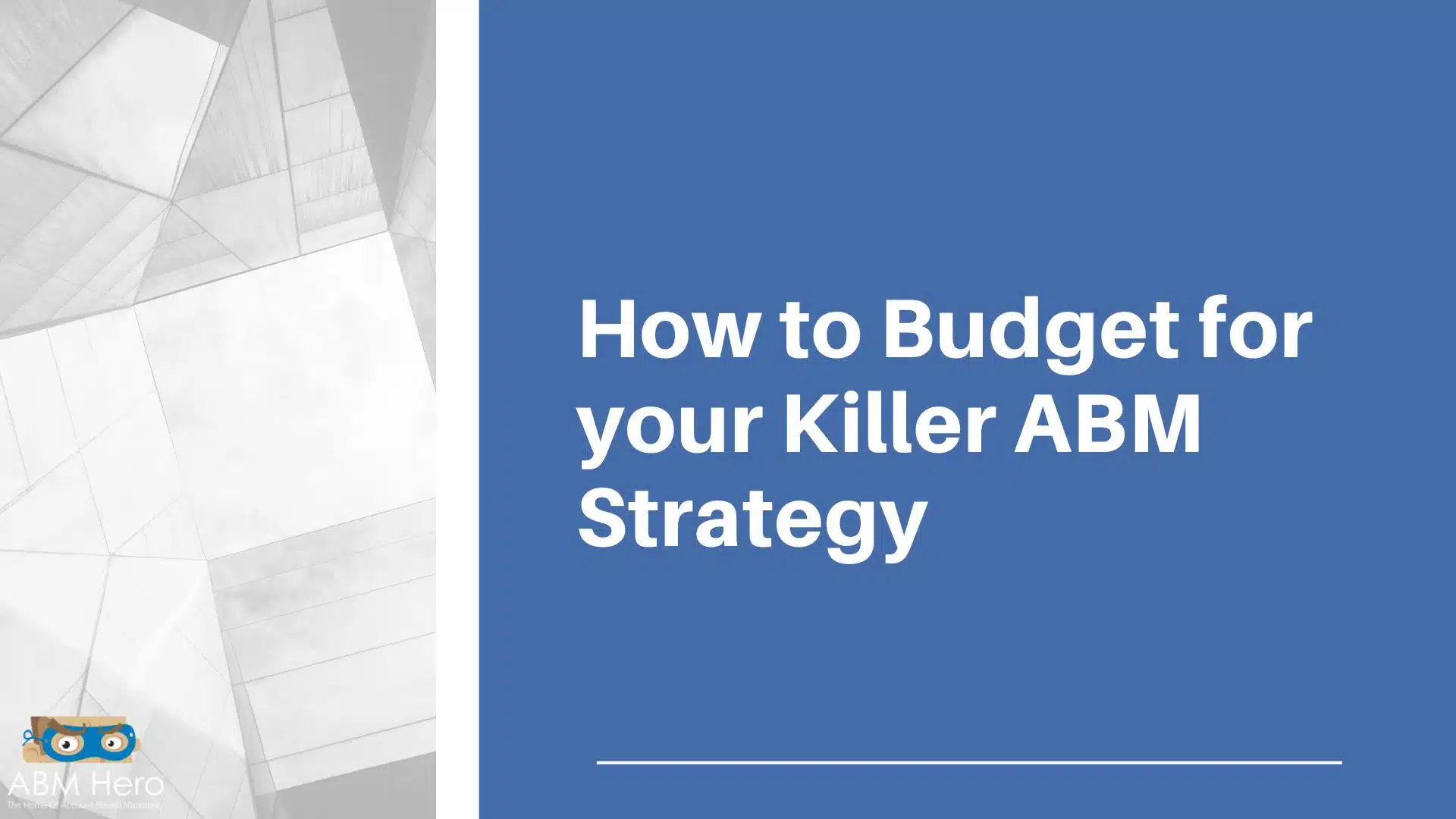Account-based marketing (ABM) has become a popular strategy for B2B marketers due to its ability to target and customize campaigns to specific accounts, allowing for more personalized, effective outreach.
However, for ABM to be successful, it requires a significant investment of financial and personnel resources, which can pose a challenge to B2B marketers working within tight budget constraints.
It is because ABM necessitates a significant upfront investment to develop and deploy a strategy tailored to each account and ongoing investments in analytics, optimization, and account-level personalization.
In addition, B2B marketers must factor in the cost of marketing tools, such as CRM and marketing automation, as well as the cost of hiring the personnel to do the leg work and collaborate with different teams to achieve the company’s overall goals.
Budgeting for your ABM strategies is more than just adding numbers to your goals. It includes a ton of work to ensure the company’s resources are applied.
In this article, we will share how to budget your killer ABM strategies and the things you should keep in mind to avoid common budgeting pitfalls.
The Importance of Budgeting your ABM Strategies
Leaders of organizations trying to craft a budget to execute an effective account-based marketing strategy often need more understanding of the nuances and complexities of the process.
Crafting an adequate budget is a delicate balance of identifying the necessary resources to invest in, such as the right personnel, technology, and data, while simultaneously ensuring reduced costs.
To make informed decisions, leaders need to deeply understand the account-based marketing landscape and the resources required to execute a successful strategy.
Furthermore, leaders need to be able to accurately assess their strategy’s return on investment (ROI), as this will determine the success of the budget.
Primary Considerations When Budgeting an ABM Campaign
Before diving deep into your budgeting process, it is important to step back and ponder the primary considerations you will stumble upon in your planning phase. Here are the following:
- Size of the business
- Number of Decision-makers
- Number of departments
- Level of brand awareness
Size of the business
It is essential to understand the size of your target market when budgeting for an Account-Based Marketing (ABM) strategy, as the organization’s size will directly impact the necessary investment to reach and engage the target accounts.
Depending on the size of the target organization, the budget needed to reach the desired accounts may be significantly higher or lower.
For instance, if you are targeting a large enterprise, you will need to allocate a larger budget to ensure that the necessary resources are available to reach and engage the target accounts.
Contrary, if you are targeting small to medium-sized businesses, the budget needed for the ABM strategy will be lower as the organization’s size is smaller.
Number of Decision-Makers
When budgeting for ABM campaigns, the number of decision-makers involved can be a critical factor that determines the campaign’s overall success.
The larger the number of decision-makers, the more complex the decision-making process can become, as each decision-maker may have different priorities and preferences that must be considered when determining the budget for the campaign.
Because of this complexity, it is crucial to allocate a sufficient budget to ensure that the needs of all the decision-makers are met, as failure to do so could result in the campaign not achieving its desired objectives.
Additionally, the budget should also be sufficient to cover any unforeseen costs that may arise during the campaign, such as unexpected changes in the market or other unforeseen external disruptions.
Number of Departments
When budgeting for Account-Based Marketing (ABM) campaigns, the number of departments within a company matters.
Each department likely has different needs and goals, and budgeting for ABM campaigns must be tailored to each department’s specific objectives.
By understanding the individual objectives of each department, companies can allocate budgets more efficiently to ensure that the appropriate resources are devoted to each department’s ABM campaigns.
Additionally, it is essential to recognize that each department may have different resources available for their ABM campaigns. By accounting for the number of departments, companies can more accurately gauge the available resources and adjust the budget accordingly.
Furthermore, by having a more granular understanding of the number of departments, companies can more effectively measure the impact of their ABM campaign.
Level of Brand Awareness
When budgeting for Account-Based Marketing (ABM) campaigns, it is crucial to assess the level of brand awareness amongst your target accounts. It is because the level of brand awareness amongst potential customers significantly impacts the success of ABM campaigns.
If the target accounts are unaware of the brand and its offerings, the campaign is likely less effective, and the investment may be wasted.
Furthermore, the target accounts have a high level of brand awareness. In that case, the ABM campaign can be tailored to meet the customer’s needs, resulting in greater engagement and a higher return on investment.
Choose Your Key Accounts List
Choosing your key accounts list is critical in developing a killer ABM strategy. When creating your list, it’s essential to consider the size of each account, its potential for growth, and its fit with your company’s objectives. Employing sound key account management techniques helps you streamline information and focus on things that matter.
With the correct list of key accounts, you can develop a budget to effectively target critical decision-makers and influencers within each account.
A well-crafted budget should include resources such as personnel, technology, and content that will support your efforts.
Once you’ve identified the accounts you want to target, you’ll need to work out the cost of targeting each one and any additional activities, such as events or advertising, that may be necessary.
Figure Out the Lifetime Value of Your Target Account
An important part of a successful ABM strategy is understanding the lifetime value of your target accounts.
It is the estimated total value of a customer over their entire relationship with your business.
To budget for your killer ABM strategy, you need to understand how much money you will likely make from each account throughout their relationship.
It will help you decide how much to invest in each account and where to allocate resources best.
You can determine your target accounts’ lifetime value by looking at their past purchases, industry benchmarks, and projections for future spending.
With this information, you can decide how to best budget for your ABM strategy. By understanding the lifetime value of your target accounts, you can lay out your long-term plans with confidence.
Choose The Account with the Highest Value
Choosing the proper accounts to target is the most critical consideration when budgeting for an ABM campaign.
Identifying high-value accounts and understanding their lifetime value is key to building an adequate budget to maximize ROI.
Leaders must consider the cost of acquiring new customers and the resources necessary to maintain relationships with existing customers.
Once the target accounts are determined, leaders must decide how much to invest in each performance.
The budget must be sustainable and will positively impact the company’s overall objectives.
Furthermore, team collaboration is essential to ensure the objectives are met. The harmony ultimately determines the success of an ABM strategy that the sales and marketing team brings to your funnel.
Make Technology an Investment
Understanding the lifetime value of your target accounts is one of the most important steps in crafting an effective ABM strategy.
Knowing how much money you can expect to make from each account over time will help you determine how much of your budget to allocate for targeting that specific group.
To figure out the lifetime value, start by looking at the total revenue generated by each account in the past year and then extrapolate that number several years into the future.
You can also factor in the cost of customer acquisition and how long customers typically stay with your business before they churn.
With this data, you can estimate the projected lifetime value of each account, enabling you to budget accurately for your ABM strategy.
Seek the Endorsement of Key Stakeholders
When budgeting for a successful ABM strategy, it is vital to get the endorsement of key stakeholders.
Start by creating a proposal outlining the campaign’s objectives and goals. And an estimate of the budget required to achieve them.
Ensure that the proposal clearly outlines the expected return on investment and the expected timeline for success.
Once the proposal has been created, present it to key stakeholders and convince them of the value of the strategy. Explain how it will benefit their business and why it is worth investing in.
Also, provide detailed information about how the budget will be allocated and how it will be monitored and tracked.
With the endorsement of key stakeholders, you can ensure that your ABM strategy has the resources it needs to bring the plans to fruition.
Proper budgeting for an ABM campaign requires a lot of research and planning.
You must build a strong understanding of your target audience, define the goals and objectives of the campaign, and consider the various budgeting options before you begin.
Consistently tracking your budget after the campaign launch will help identify areas that are overspending which can be adjusted accordingly, as well as provide valuable insight into ways to maximize your campaign’s return on investment.
By taking the proper steps to properly budget for and manage an ABM campaign, you can get the most out of your efforts and reach new heights with your business successes.





